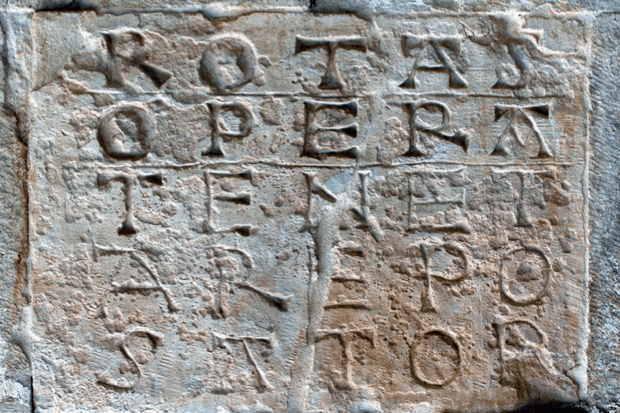What is the Sator Square, and how old is it?
A Christian symbol, a magic charm to cure rabies, a puzzle of interlocking layers that has inspired recent filmmakers, or simply a one-line tale about a hardworking farmer: the ancient five-word palindrome continues to provoke debate. Jonny Wilkes explores the history of the Sator Square and its possible meanings

Made up of 25 letters in a 5x5 grid, the Sator Square is no ordinary palindrome. Far more sophisticated than the average ‘racecar’ or ‘top spot’, this is made up of five words in Latin that all interact with each other. The words – Sator, Arepo, Tenet, Opera and Rotas – can be read horizontally and vertically, from the top and left, and the bottom and right.
Those words, especially the middle one, will be familiar to fans of Christopher Nolan’s time-reversing science-fiction thriller, Tenet (2020), as they all appear in the course of the movie. Sator is the name of the villain (played with menace by Kenneth Branagh); Arepo is a shadowy art forger; the opening scene takes place at the opera; Rotas is the name of an important security company; and Tenet, of course, is the title. By no means, however, was the Sator Square invented for the movie.
It is an ancient artefact, seen in myriad cultures over many centuries. Examples have been found all over Europe and beyond, from England to Syria and Sweden to North Africa, and dating from as early as the first century AD. Squares have been etched into clay tablets, roof tiles and walls, or written on papyrus, amulets and medieval textbooks.
Over the centuries and throughout the Middle Ages, the Sator Square was imbued with magical properties, seen as a charm to ward off evil or illness. It was believed it could cure anything from dog bites and rabies (by eating a piece of bread inscribed with the 25 letters) to toothaches, a fear of water, and insanity. In medieval Germany, a disc carved with the square was believed to be able to put out fires.
As to its meaning, breaking down the individual words offers a useful starting point. In Latin, ‘Sator’ means ‘sower’ or ‘seeder’, which could be a reference to a farmer. The meaning of ‘Arepo’ is unknown, but it could be a person’s name. ‘Tenet’ means ‘to hold’; ‘Opera’ can either be ‘with care’ or ‘work’; while ‘Rotas’ is thought to refer to ‘wheels’.
So, if read top to bottom – although most commonly known today for starting with ‘Sator’ at the top, there are existing examples beginning with ‘Rotas’ – it is possible to construct a sentence along the lines of: “The sower Arepo holds the wheels with care (or works the wheels).”
More like this
- Read more | A history of the Bible: who wrote it and when?
Of course, the Sator Square has not survived this long, across multiple civilisations, for an all-too brief story about a farmer called Arepo. The studies and debates into its meaning goes on, with the word ‘Arepo’ alone being subject to numerous theories and interpretations. Yet there is no question that it took on significant meaning in Christianity, since squares have been found in churches and in the pages of Bibles.
This may be down to the fact that the letters can be rearranged to make the words “Pater Noster” – meaning “Our Father”, the first words in the Lord’s Prayer – twice, with them intersecting at the N to form a cross. This leaves two As and two Os left over, which could be used to stand for Alpha and Omega, the first and last letters of the Greek alphabet used to refer to God (the beginning and the end). Much like the fish symbol, the Ichthus, Christians may have co-opted the Sator Square as a secret form of communicating with each other at a time when they were being persecuted.
It remains unlikely that the square originated among early Christians, though, since the earliest-known examples have been unearthed as part of the excavations at Pompeii. The city was destroyed by Vesuvius in AD 79, before Christianity had been firmly established. Theories therefore abound to the true origins of the Sator Square, from it being a Jewish symbol to its association with a number of ancient religious cults. Or it may have simply been a Roman word puzzle.
Authors

Jonny Wilkes is a former staff writer for BBC History Revealed, and he continues to write for both the magazine and HistoryExtra. He has BA in History from the University of York.

From the makers of HistoryExtra, try 6 issues of BBC History Magazine or BBC History Revealed for just £9.99 + FREE access to HistoryExtra (including ad the free Podcast) worth £34.99.




